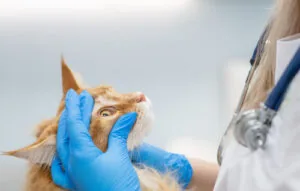Ear Mites in Cats

Is your cat itching his or her ears all the time? Do you see excess black debris in the ears? If you do, this may be a sign of ear mites. Ear mite infection is one of the most common infections to afflict cats. They are also very contagious, so quick diagnosis and treatment is essential to avoid spreading mites to other pets in your home or neighborhood. The treatments for ear mites have improved over the years and they are also easy to prevent.
What are Ear Mites?
Ear mites, which are affectionately named Otodectes, are tiny parasites, barely visible to the human eye, that live on the surface of the ear canal and eat the ear wax inside. They are generally detected with regular cat preventative care and are easy to remove, but if not treated, ear mites can cause serious blockages of the ear canal, as well as severe skin infections. Many ear infections in cats are caused by ear mites. Ear mites are highly contagious, and cats become infested by direct contact with another infested animal.
What is the life cycle of the ear mite?
It takes approximately 3 weeks for a mite to develop from egg to adult, going through a total of 5 stages. Adult ear mites live about 2 months, during which time they continually reproduce. The entire ear mite life cycle takes place on the host animal, although mites can survive for a limited time in the environment.
Do ear mites affect people?
Ear mites may cause a temporary itchy rash on susceptible people if there are infested pets in the household. Eradication of the mites from the pets will cure the problem.
What are the clinical signs of ear mites?
Ear mites are the most common cause of feline ear disease and infection. They are the second most common ectoparasite (external parasite) found on cats; the most common is the flea. Infestations are most common in kittens and young cats although cats of any age can be affected. Clinical signs of infestation vary in severity from one cat to another and include combinations of:
- Ear irritation causing scratching at the ears or head shaking
- A dark waxy or crusty discharge from the ear
- Areas of hair loss resulting from self-trauma – scratching or excessive grooming
- A crusted rash around or in the ear
- An aural hematoma – a large blood blister on the ear, caused by rupture of small blood vessels between the skin and cartilage – caused by scratching at the ears
- Skin lesions most frequently affect the ear and surrounding skin but occasionally other areas of the body may be affected.
How Did My Cat Get Ear Mites?
Ear mites are highly contagious, so there are a variety of ways your cat could have caught them. Ear mites can travel from the ears of an infected cat to any other cats in close contact. Outdoor cats are more prone to catch them from other cats while wrestling around or snuggling (basically any social interaction with an infected cat), but indoor cats can also catch them from the toys or bedding of other infected cats. Mites are very prevalent in kittens and shelter cats, so any time you adopt a new cat be sure to check their ears immediately for ear mites. It’s best to bring a newly-adopted cat in for a checkup as soon as you can.
What problems can result from an ear mite infection?
The scratching can become intense and because a cat’s hind claws are so sharp, the constant scratching can abrade and lacerate the ears, cheeks and neck as the cat endeavors to alleviate the discomfort. The scratching can also cause an aural hematoma to develop. This is a blood-filled blister that develops on the earflap. The scratching damages blood vessels inside the ear. Subsequently, leakage of blood from these vessels between the skin and cartilage of the earflap causes a large, soft, blood-blister to develop. If left untreated, a mite infestation can lead to further infections with bacteria or yeasts. The infection can also damage the eardrum and enter the inner ear.
How are ear mite infestations diagnosed?
Typical clinical signs with a history of contact with other cats or dogs would suggest the involvement of ear mites. Although ear mites cause over half of all feline ear disease, other conditions can result in very similar clinical signs and must be ruled-out before treatment is begun. A veterinarian makes the diagnosis by observing the mite. This is usually straightforward and may be done either by examination of the cat’s ears with an otoscope or by microscopic examination of discharge from the ear. If the ears are very sore, the cat may need to be sedated to allow the ears to be properly examined and treated.
How Are Ear Mites Treated?
You will need to take your cat to your veterinarian for an accurate diagnosis—he or she will take an ear sample and prescribe treatment based on the evaluation. Topical solutions, medicated ear drops, or antibiotics may be necessary. An ear cleaning might be needed as well.
You can help prevent ear mites by cleaning your cat’s ears regularly. Gently swab the inside of your cat’s ears with a small piece of cotton and an ear cleanser.
Certain products such as, Acarexx and MilbeMite are two readily available preparations for the topical (in ear) treatment of ear mites. After two doses, two weeks apart, over 90% of my patients are cured (the remaining 10% get an extra treatment in another couple of weeks).
How Can Ear Mites Be Prevented in Cats?
As with most pet parasites, hygiene and regular checkups are always key to prevention. Keep your cat’s toys and bedding clean, and check their ears on a regular basis (especially if they have had contact with other cats or other cats’ items). As mentioned previously, have any newly-adopted pets checked by your vet to help prevent ear mites from spreading to the pets already in your home. Revolution and Advantage-Multi are both labeled for the treatment and control of ear mites. That means that both products will kill ear mites as well as prevent future infections.
Share This Post
Recent Posts
About Shallowford Animal Hospital
Shallowford Animal Hospital and The Pet Spa at Shallowford are dedicated to the exceptional, compassionate care your pet deserves. Pets hold a very special place in our families, and we treat yours like our own.



